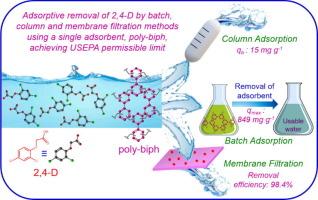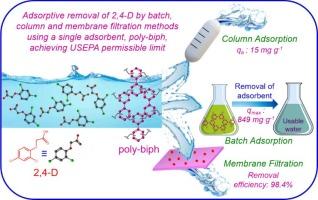采用间歇法、柱分离法和膜分离法对水中除草剂2,4-二氯苯氧乙酸的高效去除进行了研究
IF 9
1区 工程技术
Q1 ENGINEERING, CHEMICAL
引用次数: 0
摘要
采用微波辅助超交联法制备高比表面积(SABET)为1056 m2/g的聚联苯(polybiph),作为吸附水中2,4-二氯苯氧乙酸(2,4- d)的吸附剂。聚biph作为吸附剂,通过批过滤、柱过滤和膜过滤都能有效地去除2,4- d。间歇式吸附法在pH = 7时,在90 min内的最大吸附量为849 mg/g,达到了美国环境保护署(USEPA)规定的4 ppm初始浓度2,4- d的允许限量(70 ppb)。聚biph可重复利用6次吸附-解吸循环,无需任何化学活化。在膜过滤法中,5 L安全饮用水在2 bar的压力下维持150 min,渗透通量为65 L m-2h−1,最大去除率为98.4% %。而在连续固定床柱模式下,处理2.5 L除草剂溶液,可达到40 min的允许限量,突破量为15 mg/g。由于孔隙填充效应和吸附剂与吸附物之间的π-π相互作用,可以实现高效吸附。本文章由计算机程序翻译,如有差异,请以英文原文为准。


Efficient removal of herbicide 2,4-dichlorophenoxyacetic acid from aqueous solution investigated by batch, column, and membrane separation methods
Hypercrosslinking of biphenyl to form poly-biphenyl (poly-biph) with high specific surface area (SABET) of 1056 m2 g−1 by a facile microwave-assisted method was used as a potent adsorbent for removing 2,4-dichlorophenoxyacetic acid (2,4-D) from aqueous solution. The poly-biph as an adsorbent has effectively removed 2,4-D by using either of the batch, column, and membrane filtration methods. In batch adsorption method, a maximum adsorption capacity of 849 mg g−1 was estimated at pH of 7 within 90 min, achieving the permissible limit (<70 ppb) as per United States Environment Protection Agency (USEPA) when 4 ppm initial concentration of 2,4-D was used. The poly-biph was recyclable up to six adsorption–desorption cycles without any chemical activation. In membrane filtration method, 5 L of safe drinking water was sustained up to 150 min at a pressure of 2 bar and permeate flux of 65 L m−2 h−1, achieving a maximum removal efficiency of 98.4 %. Whereas, in a continuous fixed-bed column mode, 2.5 L of herbicide solution was treated, and permissible limit was achieved up to 40 min with a breakthrough capacity of 15 mg g−1. The efficient adsorption could be achieved due to pore filling effect and π-π interactions between the adsorbent and adsorbate.
求助全文
通过发布文献求助,成功后即可免费获取论文全文。
去求助
来源期刊

Separation and Purification Technology
工程技术-工程:化工
CiteScore
14.00
自引率
12.80%
发文量
2347
审稿时长
43 days
期刊介绍:
Separation and Purification Technology is a premier journal committed to sharing innovative methods for separation and purification in chemical and environmental engineering, encompassing both homogeneous solutions and heterogeneous mixtures. Our scope includes the separation and/or purification of liquids, vapors, and gases, as well as carbon capture and separation techniques. However, it's important to note that methods solely intended for analytical purposes are not within the scope of the journal. Additionally, disciplines such as soil science, polymer science, and metallurgy fall outside the purview of Separation and Purification Technology. Join us in advancing the field of separation and purification methods for sustainable solutions in chemical and environmental engineering.
 求助内容:
求助内容: 应助结果提醒方式:
应助结果提醒方式:


